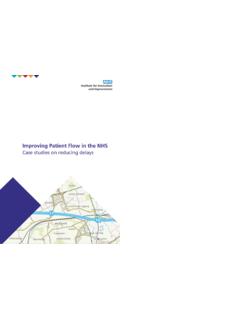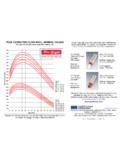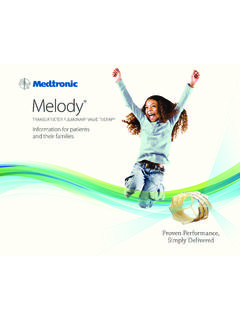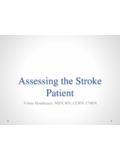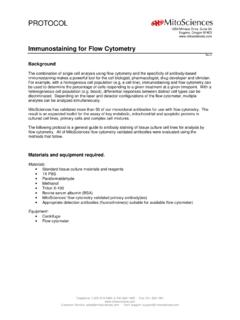Transcription of Medical Errors and Patient Safety - - RN.org®
1 Medical Errors and Patient Safety . Reviewed June 2018, Expires June, 2020. Provider Information and Specifics available on our Website Unauthorized Distribution Prohibited 2018 , , , LLC. By Wanda Lockwood, RN, BA, MA. \. Purpose The purpose of this course is to explain issues related to Medical Errors and Patient Safety concerns, including regulations, causes of Errors , root cause analysis, types of Errors , and methods to avoid Errors . Goals Upon completion of this course, one should be able to: Discuss goals and regulations related to Medical Errors . Explain changes to Medicare-Medicaid reimbursement for preventable Errors . Explain 2 different types of root cause analysis.
2 Explain how Failure Mode and Effects Analysis (FMEA) differs from other forms of root cause analysis. List and discuss 8 causes of Medical Errors . Explain the steps to identification of patients . Discuss issues related to handwriting. Explain procedures for verbal/telephone orders and reporting and hands- off communication. List and explain the 5 rights of medication administration. Explain at least 4 methods of prevent wrong-route Errors . List at least 5 items from the do-not-use list of abbreviations. Explain the difference among critical tests, critical results, and subsets of critical results. Explain the 3 steps to prevent wrong site, wrong procedure, and wrong person surgery Errors .
3 Explain handwashing and alcohol rub techniques for control of nosocomial infections. Introduction The extent of Medical error was brought to the attention of the general public in 1999 with the Institute of Medicine's (IOM's) report To Err is Human. The study found that over half of the adverse events at two major hospitals related to Medical Errors . It went on in chilling detail, describing people who had died from mistakes, had the wrong limbs amputated, or suffered serious health crises. The Joint Commission defines Medical error as An unintended act (either of omission or commission) or one that does not achieve its intended outcome.. Some Medical Errors are caused by true accidents, but most are caused by Errors , such as failing to follow a standard of care.
4 Unfortunately, many Errors are systematic and related to ineffective processes, such as a failure in communication or insufficient staffing, making it difficult to pinpoint responsibility. Further compounding the problem is that many malpractice insurance policies explicitly state that the insured should make NO admission of liability, despite this being directly counter to Medical ethics. (In response to this, some states have passed legislation that explicitly states that saying I'm sorry is not an admission of negligence.) Medical Errors can be frightening for patients , but those who commit Errors may be very shaken by the experience, feeling guilty and fearful of losing their jobs, losing respect of others, and being sued.
5 Goals and regulations There is a growing consensus that Medical Errors must and CAN be controlled and increasing regulations requiring that they be reported. The Joint Commission has issued the 2008 National Patient Safety Goals, providing strict standards to improve Patient Safety and reduce Medical Errors . Link: Joint Commission 2008 National Patient Safety Goals It's important to realize that these Safety goals are those that are used as part of accreditation assessment in an effort to reduce Medical Errors , but they do not cover all potential Errors . Procedures are in place for reporting of sentinel events (unexpected events not related to a Patient 's condition, such as death or serious injury), and compliance with Safety goals is assessed during accreditation.
6 The Federal Center for Medicaid and Medicare Services has issued a new rule that will take effect October 2008. Under this rule, hospitals will not be reimbursed for treatment related to preventable conditions, such as those related to Medical error or improper care. Additionally, the costs cannot be conferred upon the Patient , so institutions must absorb the costs related to Medical Errors . This provides a strong motivating force for compliance. Medicare payments have been based on diagnosis-related groups (DRGs), but institutions can apply for a higher reimbursement rate if complications occur. Thus, institutions that increased infection rates or complications received higher reimbursement and those that decreased infection rates also decreased profits not exactly a motivation to improve care.
7 Eight secondary conditions have been identified as no longer qualifying for additional payments because they are preventable: Preventable complication Incidence/. 2006. Object left in during surgery 764. Air embolism 45. Blood incompatibility 33. Catheter-associated urinary tract infection 11,780. Pressure ulcer 322,946. Vascular-catheter-associated infection No data Mediastinitis after coronary artery bypass grafting 108. Fall from bed 2591. This change in reimbursement cancels the monetary advantage of providing poor care to some degree although the changes are not so clear because when costs substantially exceed the DRG, reaching a threshold amount, Medicare will still provide higher reimbursement.
8 However, the real impetus is related to knowing that this is the beginning step in making organizations accountable, not the last step. While awaiting federal action, some states have enacted their own regulations to improve Safety , and some now require reporting of hospital-acquired infections and/or reporting of MRSA infections, and 25 states currently require mandatory reporting of Medical event reporting rules and statutes for all states that include some type of mandatory reporting are available at the National Academy for State Health Policy. There is an alphabetical listing of states with links to rules and statutes: National Academy for State Health Policy, state links Florida is a good example of government and public concerns spurring legislation, sometimes at odds with each other.
9 In 2004, the Florida Legislature passed cutting-edge legislation requiring that information about Patient outcomes, such as mortality rates and infection rates, be made public and that patients be notified when they were involved in an adverse event. It also mandated Patient Safety education for healthcare providers. Florida set up the Florida Patient Safety Corporation, which established a voluntary reporting system for near-misses, assuring anonymity, which most authorities believe is essential to honest reporting. However, in 2004, voters approved two amendments backed by the Florida Trial Attorneys: Patient 's Right to Know about Adverse Medical Incidents Act (Amendment 7), which allows patients access to all records about their care (including previously protected peer review findings).
10 Three Strikes and You Are Out Act (Amendment 8), which provides for revocation of license to practice for physicians with 3 adjudicated malpractice suits. While the legislature has made some modifications trying to align the different regulations, the result has been an increase in out-of-court settlements because physicians fear losing a judgment and endangering their licenses, and a marked decrease in reporting of Medical Errors because anonymity is not protected. Currently, Medical Errors must be reported (Code 15 report) to the state within 15. days. Monthly and annual reports of adverse events (deaths, injury) are available online. Link: Florida Risk Management Data Florida's Amendment 7 is also at odds with the federal Patient Safety and Quality Improvement Act (2005), which established a national database for reporting of voluntary information about Medical Errors in order to develop more effective Safety measures.










